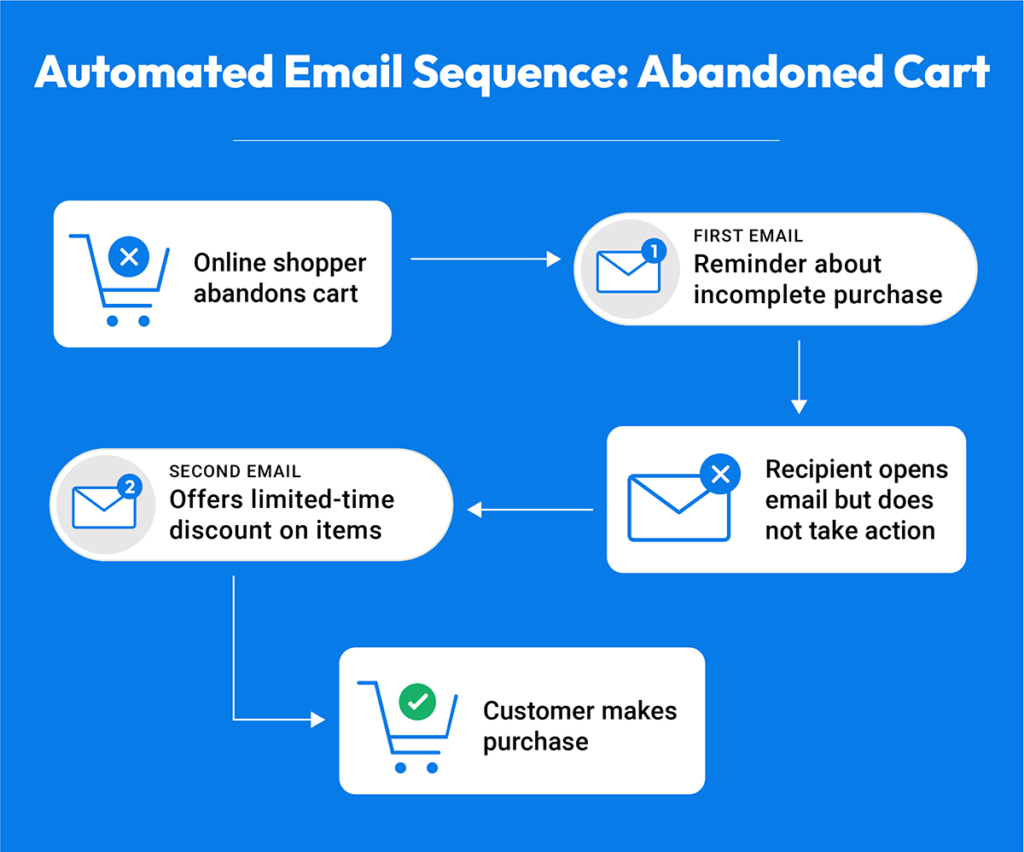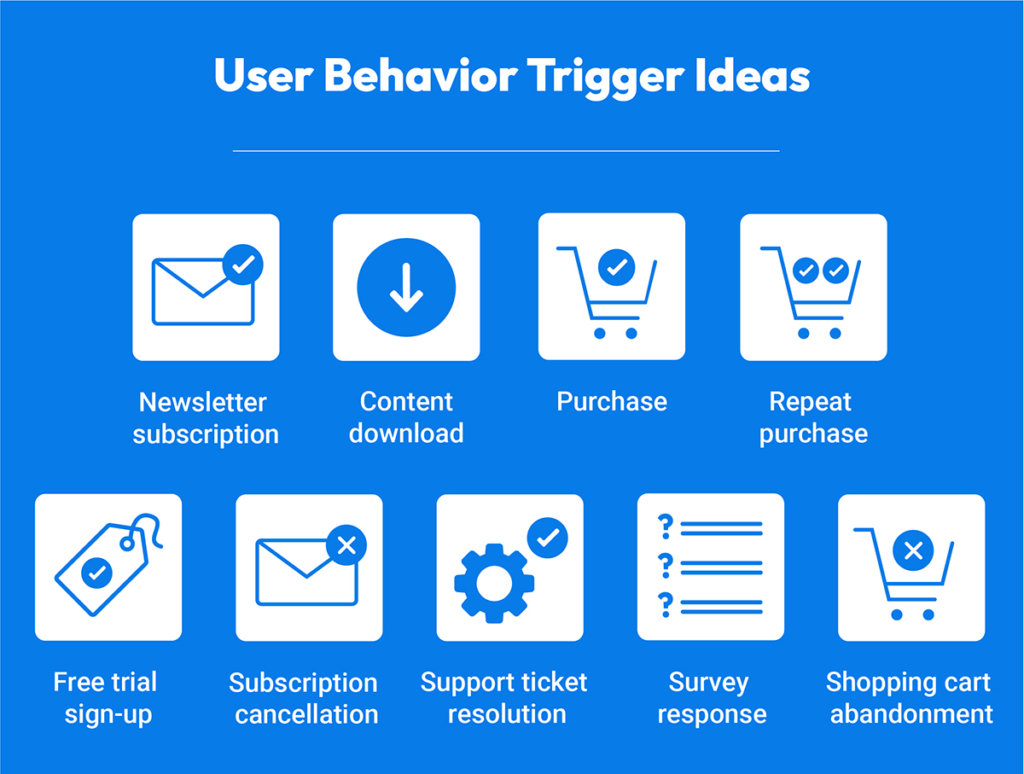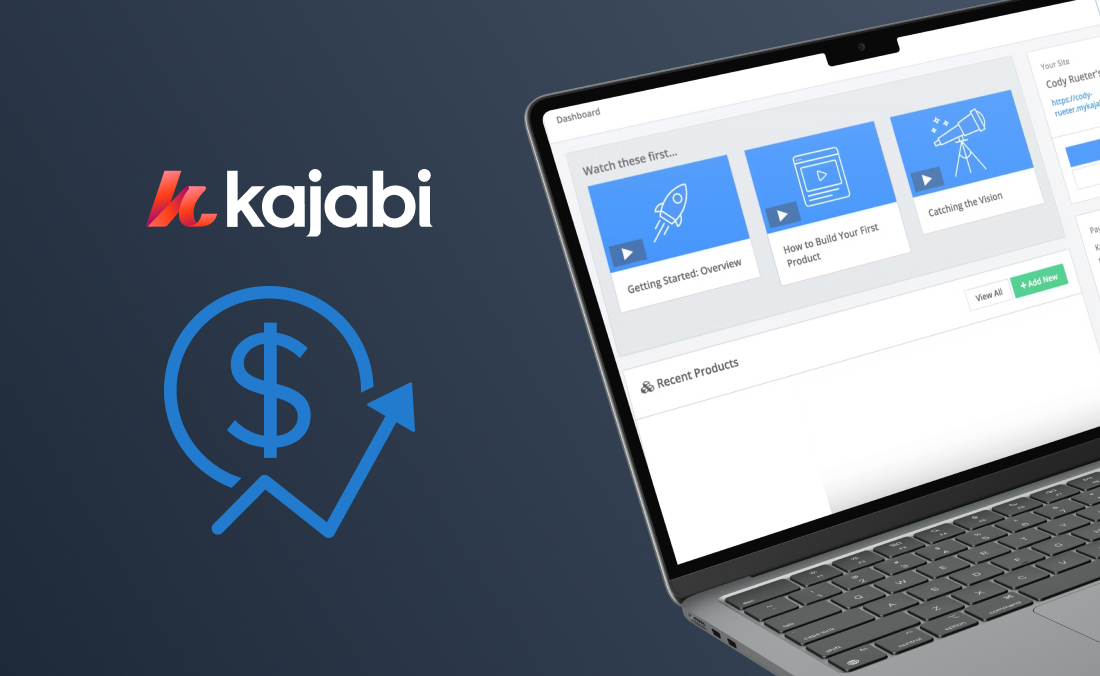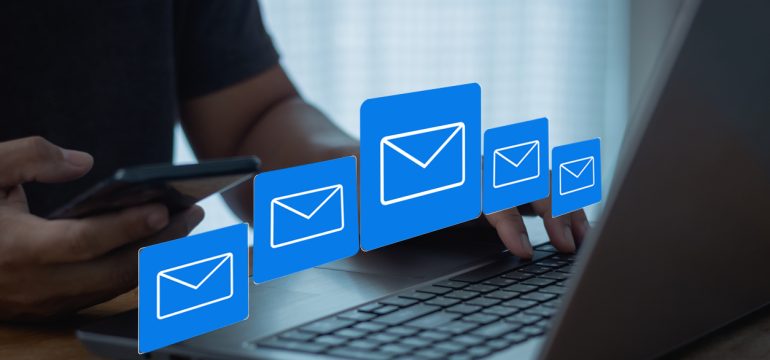
Automated emails include series of emails planned out in a timed sequence, as well as one-off, interruptive communications like new product announcements. Both types of email campaigns help to build your brand, keeping your audience engaged with your products and services without taking you away from daily responsibilities. To see results from automated email marketing, you will need to develop valuable content that matters to your audience and build trust by staying consistent.
Email Sequences & Your Sales Funnel
Email sequences need to correspond with strategic points along your sales funnel to be effective. Determining what messages, offers, and content will resonate with your contact given their stage in the buyer journey – and having a clear purpose for each email – will help you develop a successful email campaign.
For example, email sequences that intend to move someone from an acquired lead to an activated customer may focus on first-time buyer deals or educational content that builds trust. Automated emails geared toward client retention will feature more personalized messages, such as tips on how to use a previously purchased product or service.
Value Consistency and Frequency, Not Perfection
One of the basic features of any email marketing software is scheduling – the ability to plan exactly when a contact receives an email, down to the minute. The precision of this feature is helpful, but it’s easy to get lost in the weeds of finding the perfect moment. It’s much more beneficial for your brand to focus on consistent, substantive communication with your audience – building customer relationships by valuing frequency over perfection. Sporadic email communications will likely have a net-zero impact, and can even be detrimental to list-building by driving up unsubscribe rates.
Plan Blocks of Content
A major way to improve email consistency is through planning out the year in blocks. Schedule email communications in advance to prevent overloading subscribers during certain times of the year and then scrambling to create content during quieter seasons. Having a bird’s eye view of email communications will also give you a better picture of customers’ experiences, allowing you to create a more holistic email marketing strategy.
Start with Core Sequences
Start by automating core sequences that ensure no contacts fall through the cracks. These standard communications could include emails such as:
- Welcome emails for new subscribers
- Onboarding sequences for new customers
- Abandoned cart emails to encourage purchases
- Purchase confirmation emails and feedback requests
- Educational lead nurturing sequences sent to potential customers
- Follow-up emails to re-engage customers with lapsed subscriptions
Also known as “drip campaigns,” regular automated emails are an effective way to stay top-of-mind and remind your audience why they value your product or service. Once you establish core email marketing campaigns, you can then choose when to vary the content your subscribers receive to maintain their interest over time. For example, send promotional emails with limited-time offers such as discount codes or reduced pricing, or run seasonal campaigns that correspond with relevant holidays or events.
Identify the Most Effective User Behavior Triggers
Automated emails are most often triggered by specific actions users take on your website. But not every action warrants a triggered email, so you will need to be careful that your audience isn’t getting repeat emails or an overwhelming number of messages. As you experiment with email automation, narrow down the actions that warrant additional correspondence. Track open rates, unsubscribe rates, number of clicks, and other relevant KPIs to identify the most effective triggers.

Create Strategic Audience Segments
Most businesses already have an email list, even if they haven’t implemented email automation yet. This list may come from an email sign-up form on your website, or simply be compiled from years of doing business with a variety of contacts. Existing email lists allow businesses to get started right away with email automation, and it’s important to create audience segments first.
Tag Contacts Throughout the Customer Journey
Dividing your audience into smaller groups based on meaningful, shared characteristics helps you reach the right people with the right message. You can’t rely on one message to resonate with every audience member in the same way. Email automation software makes segmentation easy, automatically tagging contacts based on certain criteria (such as location or purchase history) and allowing you to create manual tags as needed.

Keep in mind that your contacts may lose or gain tags as they progress in the customer journey. Audience segmentation can’t perfectly divide your contacts into distinct groups, but it allows for significantly better personalization than a master mailing list that doesn’t account for the many different types of contacts who interact with your business.
Tailor Your Message to Specific Audiences
Once your contact list is divided into relevant segments, be sure to adapt the messages you send to these different audiences. Each email sequence should be crafted to resonate with your audience’s specific values, pain points, purchase patterns, and other factors that influence how someone engages with your brand.
Automate Workflows to Create Messages Your Subscribers Value
For example, the best emails for a personal trainer to send to their new clients will be very different depending on what services those clients signed up for and why they purchased. One person may be looking for community and accountability as they develop healthy habits, while another person is training for a particular sport or event. These individuals will likely value very different offers, educational information, training tips, and so on. The more your email messages are tailored to the audience receiving them, the more likely it is your subscribers will value hearing from your business on a regular basis.
Product-led businesses in particular, such as eCommerce companies, can take advantage of automated workflows to upsell and cross sell products as they detect patterns in purchase behaviors across different audiences. Instead of relying on assumptions, businesses using automated email marketing tools have access to real-time customer analytics that are able to refine the messages which resonate with specific audiences.
A/B Test Email Variants to Improve on Your Success
Testing plays a significant role in developing successful automated email sequences. Most email automation software comes with native A/B testing tools, allowing you to present different versions of your email campaign to equal portions of your audience – so you can see which version performs better and optimize future campaigns for higher conversion rates. Split tests are a straightforward method for continually making improvements to your email campaigns while learning key insights about your audience.
Just remember to run A/B tests when your sample size is large enough to detect patterns in user behavior (usually around 1,000 email subscribers), and only test one variable at a time. Running tests with multiple changes will muddle the results as you won’t be sure which change made a difference.
Want more details on A/B testing emails? Read our guide to Email A/B Testing: What It Is, and Why Should You Do It
Integrate Email Marketing with Your Broader Marketing Strategy
Successful email marketing doesn’t happen in a vacuum, isolated from your marketing strategy and other marketing efforts. The messages customers receive from you should be part of a holistic marketing strategy that continually presents your target audience with a compelling, cohesive message about your brand. Email automation tools make consistent email correspondence possible for small business owners by automating audience segmentation, A/B testing, and even providing templates.
But keep in mind that email automation software requires integration with landing pages, lead magnets, lead management software, and other key components of your marketing plan. All in one marketing software removes the need for coordination between many separate applications, consolidating email and other marketing channels in the same platform.
It’s easy to lose sight of your overall marketing plan when the information you need is scattered between multiple applications. All in one marketing software takes email marketing to the next level, simplifying internal processes and helping you send your audience a powerful, consistent message from the first email they open.
Kartra’s all in one marketing software provides email automation that seamlessly integrates with your other marketing channels.
About Kartra
This blog is brought to you by Kartra, the all-in-one online business platform that gives you every essential marketing and sales tool you need to grow your business profitably – from sales pages and product carts to membership sites, help desks, affiliate management and more. To learn how you can quickly and easily leverage Kartra to boost your bottom-line, please visit kartra.com.


